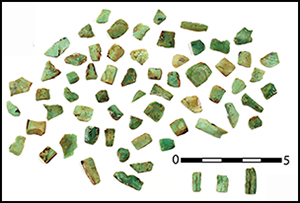Crossref Citations
This article has been cited by the following publications. This list is generated based on data provided by
Crossref.
Weiss, Elizabeth
2015.
The surface of bones: methods of recording entheseal changes.
Surface Topography: Metrology and Properties,
Vol. 3,
Issue. 3,
p.
034003.
Daura, Joan
Sanz, Montserrat
Ramos, Jordi
Riera, Santiago
Miras, Yannick
Allué, Ethel
Picornell-Gelabert, Llorenç
López-Reyes, Dani
Albert, Rosa Maria
Macià, Laia
Domènech, Rosa
Martinell, Jordi
Fornós, Joan J
and
Julià, Ramon
2016.
Palaeoenvironmental record of the Cal Maurici wetland sediment archive in Barcelona (NE Iberian Peninsula) between c. 6000 and 4000 cal. yr BP.
The Holocene,
Vol. 26,
Issue. 7,
p.
1020.
Gibaja, Juan F.
Fontanals-Coll, Maria
Dubosq, Stephanie
Oms, F. Xavier
Augé, Anna
Santos, Francisco Javier
Morell, Berta
and
Subirà, M. Eulàlia
2017.
Human diet and the chronology of neolithic societies in the north-east of the Iberian Peninsula: the necropolises of Puig d’en Roca and Can Gelats (Girona, Spain).
Archaeological and Anthropological Sciences,
Vol. 9,
Issue. 5,
p.
903.
Allué, Ethel
Picornell-Gelabert, Llorenç
Daura, Joan
and
Sanz, Montserrat
2017.
Reconstruction of the palaeoenvironment and anthropogenic activity from the Upper Pleistocene/Holocene anthracological records of the NE Iberian Peninsula (Barcelona, Spain).
Quaternary International,
Vol. 457,
Issue. ,
p.
172.
Morell, Berta
Duboscq, Stephanie
Masclans, Alba
Remolins, Gerard
Pou, Roser
Martí, Miquel
Barceló, Joan Antón
Oms, Xavier
Santos, Francisco Javier
Mozota, Millán
Subirà, Maria Eulàlia
and
Gibaja, Juan F.
2018.
Chronology of the Neolithic Necropolis at Camí de Can Grau (NE-Iberian Peninsula). Funerary pattern changes and long-distance raw material exchanges.
Comptes Rendus Palevol,
Vol. 17,
Issue. 6,
p.
399.
Abe, Yoshinari
Nakamura, Ayana
Suzuki, Shusaku
Tantrakarn, Kriengkamol
Nakai, Izumi
Zöldföldi, Judit
and
Pfälzner, Peter
2019.
Use of variscite as a gemstone in the Late Bronze Age Royal Tomb at Qatna, Syria.
Journal of Archaeological Science: Reports,
Vol. 27,
Issue. ,
p.
101994.
Masclans, A.
Duboscq, S.
Achino, K.F.
Morell, B.
and
Gibaja, J.F.
2019.
Looking for sexual differences during the middle Neolithic in the northeast of the Iberian Peninsula.
Journal of Archaeological Science: Reports,
Vol. 26,
Issue. ,
p.
101858.
Cintas-Peña, Marta
and
García Sanjuán, Leonardo
2019.
Gender Inequalities in Neolithic Iberia: A Multi-Proxy Approach.
European Journal of Archaeology,
Vol. 22,
Issue. 4,
p.
499.
Borrell, Ferran
Bosch, Josep
Gibaja, Juan Francisco
Schmidt, Patrick
Terradas, Xavier
and
Biehl, Peter F.
2019.
The status of imported Barremian-Bedoulian flint in north-eastern Iberia during the Middle Neolithic. Insights from the variscite mines of Gavà (Barcelona).
PLOS ONE,
Vol. 14,
Issue. 11,
p.
e0224238.
Lillios, Katina T.
2019.
The Archaeology of the Iberian Peninsula.
Navarrete, Vanessa
Bosch, Josep
and
Saña, Maria
2020.
Prácticas ganaderas y minería neolítica: nuevos datos de las minas de variscita de Gavà (Barcelona).
Trabajos de Prehistoria,
Vol. 77,
Issue. 2,
p.
337.
Tarifa-Mateo, N.
Regert, M.
Craig, O.E.
Rosell-Melé, A.
Clop, X.
and
Saña, M.
2021.
Pottery use in the mining site of variscite Mines de Gavà (Barcelona, Spain) during the 4th millennium BC based on organic residue analysis.
Journal of Archaeological Science: Reports,
Vol. 38,
Issue. ,
p.
103080.
Edinborough, Kevan
Martineau, Rémi
Dufraisse, Alexa
Shennan, Stephen
Imbeaux, Marie
Dumontet, Anthony
Schauer, Peter
and
Cook, Gordon
2021.
A Neolithic population model based on new radiocarbon dates from mining, funerary and population scaled activity in the Saint-Gond Marshes region of North East France.
Quaternary International,
Vol. 586,
Issue. ,
p.
121.
Harding, Anthony
2021.
Salt.
Díaz-Acha, Yael
Campeny, Marc
Casas, Lluís
Di Febo, Roberta
Ibañez-Insa, Jordi
Jawhari, Tariq
Bosch, Josep
Borrell, Ferran
Jorge-Villar, Susana Esther
Greneche, Jean-Marc
Tauler, Esperança
and
Melgarejo, Joan Carles
2022.
Colours of Gemmy Phosphates from the Gavà Neolithic Mines (Catalonia, Spain): Origin and Archaeological Significance.
Minerals,
Vol. 12,
Issue. 3,
p.
368.





